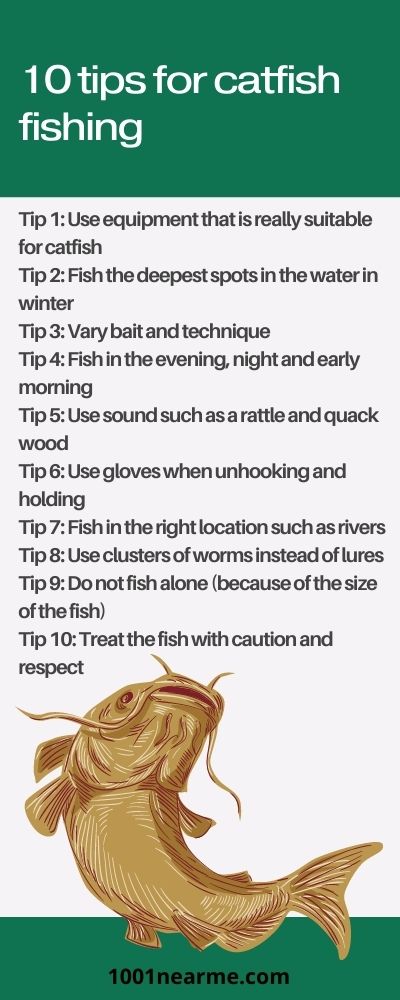The European catfish is a fish which is also called trap or fish devil. The catfish can grow very long and has a flat mouth. The fish can grow over 2.5 meters long and weigh over 100 kg. Catfish have a large belly and a strong, large tail. On its large mouth, the catfish has 6 beard hairs. The eyes are small and the skin is unscaled. The fish are dark green to black on the top and the underside is silver to white in color. Up to a length of 130 centimeters, the catfish is a relatively slender fish but above that its weight and size increase dramatically.
What does a catfish eat?
Juvenile catfish eat mostly invertebrates at the bottom of a river. Large specimens eat have a very large mouth which allows them to eat large bream, zander, eels, carp, coots and amphibians.
Habitat
European catfish feel best at home in rivers with varying water levels. During the day, catfish are in deep bowls of water and at night they hunt in shallower waters. Catfish live primarily in freshwater, such as rivers, lakes, canals and ditches. Some species may also live in brackish or saltwater. Catfish prefer still or slow-flowing water with abundant vegetation and other cover, such as rocks, reed beds and bank cover.
Vegetation
Catfish spawn from May through July at water temperatures above 18 degrees. In a plant-rich area, the fish lay sticky eggs about 3 mm in size in a shallow pit. Females lay up to 30,000 eggs per kilogram of body weight! The nest is guarded by males for about a week until the eggs hatch.
How old can a catfish get?
The maximum age of a catfish varies depending on the species. In the wild, catfish can live between 15 and 25 years on average, with some specimens that can live older. In captivity, however, catfish can live beyond 25 years of age.
How big does a catfish get?
The size of a catfish varies depending on the species. The European catfish (Anguilla anguilla) is the largest species, with adults reaching an average length of 2-2.5 meters and weighing up to 15 kg. The American catfish (Anguilla rostrata) is slightly smaller, with adults averaging 1.5-2 meters in length and weighing up to 8 kg. There are also smaller species such as the Japanese catfish (Anguilla japonica) that grow to about 1 meter in length.
Biggest catfish ever caught
A very large catfish that was caught was one of 278 centimeters long and weighed 144 pounds. This fish was caught in the Po, a river in Italy according to Wikipedia. There are also many stories of very large catfish over 3 meters and well over 100 kilograms. However, many catches are not properly measured and weighed and there are not always photos of them. However, the fact is that catfish have been on the rise in recent years and specimens over 2 meters are being caught more and more often.
M catfish fishing
The catfish is on the rise and is not an endangered species. Many anglers would like to see the fish allowed to be actively fished, farmed and released. Some countries are actively fishing for this fish.
Catfish have been caught by humans for centuries for food and commercial purposes. Catfish fishing can be done in a variety of ways, such as with rods, nets or fishing hooks. Commercial catfish fisheries often use large nets to catch large numbers of catfish at a time.
However, there are also concerns about the sustainability of catfish fishing. Some catfish species are endangered or vulnerable, and restrictions on catching them have been placed to protect their populations. Commercial catfish fishing is also often criticized for the impact it can have on other species, such as bycatch of protected animals.
Bait used
Catfish are caught with large bunches of dew piers and with lures such as spoons, crankbaits and rubber lures. The fish hear very well and but see relatively little. Lures with a rattle can be more successful because of this. Catfish are not very picky and will eat a wide variety of prey, so there are many different bait options to catch catfish. Some common bait options are:
- Fish: Catfish are fish eaters par excellence, so fish is a popular choice as bait. Bait fish such as perch, pike, carp, and smaller fish such as crabs, worms, crustaceans and frogs are often used.
- Lures: Catfish can also be attracted to lures such as spiders, streamers and puppets.
- Live bait: Live bait such as worms, frogs, and crabs can also be used to catch catfish.
- Dead prey: Dead prey such as poultry, wings, or small mammals can also be used.
It is important to remember that each species of catfish chooses different prey and the bait choice depends on the species you are looking for. It is also important to observe local laws and restrictions when fishing for catfish.
I want to fish catfish, what do I need?
If you want to fish catfish, you will need the following:
- Fishing license: Always check if you need a valid fishing license for the location you will be fishing and if there are any restrictions on catching catfish.
- Equipment:
- Rig and reel: A medium to heavy rod with a reel with good drag is suitable for catfish fishing.
- Line: Use a strength line suitable for the size of fish you expect to catch.
- Bait: Choose baits that lure the catfish, such as fish, frogs, worms, crabs or lures.
- Accessories: A net, hook tackle, gaff or rod stand are useful for catching and removing the fish from the hook.
- Know your catch area: Choose an area with adequate cover and vegetation where catfish can hide, such as reed beds, shoreline cover, rocks or shipwrecks.
- Techniques: There are several techniques for catching catfish, such as using a setup called an eelpout, fishing with a lure rod or fishing with a float. Practice and experiment with different methods until you find a technique that works for you and the fish in your area.
- Respect for nature: Observe the laws and regulations for fishing, catch only what you need and let the rest of the fish live. This is good for fish populations and the health of the ecosystem.
- Safety: Make sure you are safe while fishing, and careful when handling equipment and fish.
Keep in mind that catfish are protected or endangered in some areas, so there are restrictions on catching and selling these species. So, before fishing for catfish, it is important to make sure they have been caught legally and ensure sustainable fishing.
Is a catfish dangerous?
Catfish are not normally dangerous to humans. Hot ones are large hunters though, eating mostly fish, and they have no natural predators in the wild. They are able to defend themselves when threatened or attacked. Catfish have sharp teeth and powerful jaws, so they might bite if they feel threatened. There are no known cases of humans being attacked by a catfish, so the chances are slim. It is important, however, to show respect for wild animals and not to do things that might threaten them.
However, it is important to remember that some species of catfish can be infected with the fish worm Anguillicola crassus, which can cause pneumonia and other health problems in people who eat the fish. It is therefore important to cook the fish thoroughly before consumption and to ensure hygienic practices during filleting and preparation.
Can you eat catfish?
Of course, it is best to return a fish to the water where it was caught immediately after catching it. The fish can continue to live and reproduce. However, it is possible to eat a catfish. This is also commonly done in some countries.
Catfish are often eaten and are considered a delicacy in many parts of the world. Catfish are a source of protein and are low in fat. There are several ways to prepare catfish, including grilling, baking, smoking or cooking in soup or sauce. Catfish are commonly eaten in Europe, Asia and North America.
It is important to remember that some species of catfish are protected or endangered and therefore there are restrictions on their capture and sale. So, before eating catfish, it is important to make sure they have been caught legally and ensure sustainable fishing.
This is what catfish tastes like
The taste of catfish varies depending on how it is prepared and what part of the fish is eaten. Catfish is often described as having a mild, subtle flavor, with a bit of sweetness. The taste is most similar to other freshwater fish such as carp or perch, but can be slightly saltier.
The meat of catfish is white and lean, and is often described as soft and tender. It is a popular choice for sashimi and sushi because it is sweet and tasty. Catfish are often eaten grilled, baked, steamed or broiled, or in soups and sauces.
However, it is important to remember that the taste can vary depending on the age and diet of the fish, and that some catfish can have a bitter taste due to the environment in which they live. Therefore, it is recommended to cook catfish before consumption, and to ensure hygienic practices during filleting and preparation.
How to prepare a catfish?
There are many different ways to prepare a catfish, depending on personal taste and preference. Here are some popular methods:
- Grill: Slice the catfish and grill the meat until cooked. This is a popular way to eat catfish in the summer.
- Frying: Slice or fillet the catfish and bake the meat in the oven or in a pan. Use butter, oil or another flavorful oil for extra flavor.
- Smoking: Smoke the catfish for a unique flavor. This is a popular way to eat catfish in Europe and North America.
- Cooking in soup or sauce: Slice the catfish and cook it in a soup or sauce. This is a popular way to eat catfish in Asia.
It is important to remember that catfish can contain a fish worm Anguillicola crassus that can lead to pneumonia and other health problems. Therefore, it is important to cook catfish before consumption and to ensure hygienic practices during filleting and preparation. It is also important to remember that some species of catfish are protected or endangered and therefore there are restrictions on their capture and sale. So, before eating catfish, it is important to make sure they have been caught legally and to ensure sustainable fishing.
Here to find an angling store
To buy equipment for catfish fishing, look for an angling store near you. Check out the map below for zeken in your area.





















